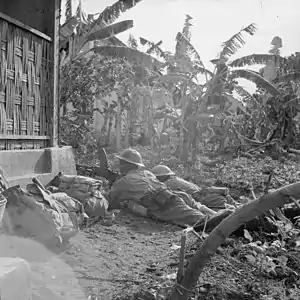9th Jat Regiment
The 9th Jat Regiment was an infantry regiment of the British Indian Army. It was formed in 1922, after the Indian government reformed the army, moving from single battalion regiments to multi battalion regiments.
| 9th Jat Regiment | |
|---|---|
 | |
| Active | 1922–1947 |
| Country | British India |
| Branch | Army |
| Type | Infantry |
| Engagements | World War II |
World War II
The Regiment saw a great deal of fighting with the Jats showing their mettle in North Africa, Ethiopia, Burma, Malaya, Singapore, and Java-Sumatra. A large number of gallantry awards were won including a Victoria Cross (by Jemadar Abdul Hafiz) and two George Crosses (by Islam-ud-Din and Abdul Rahman). At the end of the war the Regiment, in company with other regiments of the Indian Infantry, dropped the numeral 9 from its title and became simply the Jat Regiment. After independence it was allocated to the new Indian Army.
Formation
- 1st Battalion ex 6th Jat Light Infantry
- 2nd Battalion ex 119th Infantry (The Mooltan Regiment)
- 3rd Battalion ex 10th Jats
- 4th Battalion ex 18th Infantry
- 10th (Training) Battalion ex 2nd Battalion, 6th Jat Light Infantry[1]
Formed in World War II
- 7th Battalion
- 8th Battalion
- 9th Battalion
- 14th Battalion
- 15th Battalion [2]
See also
References
- Sharma, p.159
- Sharma, p160
Sources
- Sharma, Gautam (1990). Valour and sacrifice: famous regiments of the Indian Army. Allied Publishers. ISBN 81-7023-140-X.
This article is issued from Wikipedia. The text is licensed under Creative Commons - Attribution - Sharealike. Additional terms may apply for the media files.